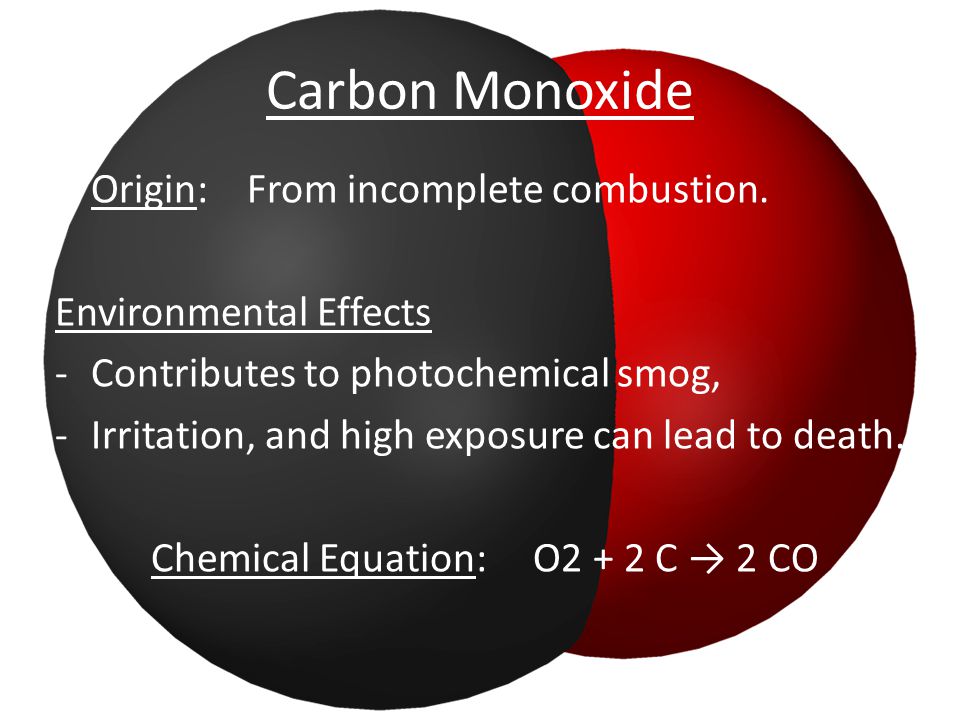
In the presence of sufficient oxygen LPG burns to form water vapour and carbon dioxide as well as heat. Carbon monoxide COa colorless odorless tasteless and toxic air pollutantis produced in the incomplete combustion of carbon-containing fuels such as gasoline natural gas oil coal and wood.

The harmful effects of carbon monoxide are generally considered to be due to tightly binding with the prosthetic heme moiety of hemoproteins that results in interference with cellular operations for example.
Environmental effects carbon monoxide. The effects on health of prolonged but low level exposure to carbon monoxide CO are unclear. Studies of carbon monoxide exposure focus mainly on short term effects in experimental settings or on long term effects in cases of accidental poisoning. Exposures in long term case studies are often of unknown levels and duration.
Patients are sometimes exposed to short periods of acute. The harmful effects of carbon monoxide are generally considered to be due to tightly binding with the prosthetic heme moiety of hemoproteins that results in interference with cellular operations for example. Carbon monoxide binds with hemoglobin to form carboxyhemoglobin which affects gas exchange and cellular respiration.
Inhaling excessive concentrations of the gas can lead to hypoxic. Revised Evaluation of Health Effects Associated With Carbon Monoxide Exposure. An Addendum to the 1979 EPA Air Quality Criteria Document for Carbon Monoxide Benignus V L.
Revised Evaluation of Health Effects Associated With Carbon Monoxide Exposure. An Addendum to the 1979 EPA Air Quality Criteria Document for. Carbon Monoxide is a gas mainly emitted by vehicles or machinery that burn fossil fuels.
It is one of the six air pollutants controlled by EPAs National Ambient Air Quality Standards NAAQS. Carbon monoxide COa colorless odorless tasteless and toxic air pollutantis produced in the incomplete combustion of carbon-containing fuels such as gasoline natural gas oil coal and wood. The largest anthropogenic source of CO in the United States is vehicle emissions.
Breathing the high concentrations of CO typical of a polluted environment leads to reduced oxygen O. Carbon monoxide CO an odorless colorless gas. It is produced any time a fossil fuel is burned and it can cause sudden illness and death.
CDC works with national state local and other partners to raise awareness about CO poisoning and to monitor CO-related illness and death surveillance data in the US. Carbon monoxide poisoning has adverse health effects and can be fatal. Properly functioning gas appliances produce little if any carbon monoxide.
In the presence of sufficient oxygen LPG burns to form water vapour and carbon dioxide as well as heat. Carbon monoxide CO is a colorless odorless and toxic gas which is predominantly produced by incomplete combustion of carbon-containing materials. Incomplete combustion occurs when insufficient oxygen is used in the fuel hydrocarbon burning process.
Consequently more carbon monoxide in preference to carbon dioxide is emitted. Some examples of this are the following. Carbon monoxide CO poisoning is common potentially fatal and probably underdiagnosed because of its nonspecific clinical presentation.
CO has profound effects on oxygen transport and to a lesser degree peripheral oxygen utilization. In addition to the extended summary below a brief table to facilitate emergent management is provided. Pollution is the introduction of contaminants into the natural environment that cause adverse change.
Pollution can take the form of any substance solid liquid or gas or energy such as radioactivity heat sound or light. Pollutants the components of pollution can be either foreign substancesenergies or naturally occurring contaminants. Although environmental pollution can be caused.
The effects of environmental pollution especially air pollution is alarming and the impact is disproportionately prevalent in developing countries among low-income earners children geriatrics and other vulnerable groups. The knowledge of the causes and consequences of environmental pollution is paramount but the cost of inaction in huge. Different physical and chemical approaches have.
To evaluate the environmental effects of different end-of-life management options for the takeaway containers at the EU level. The functional unit for the first two goals of the study is defined as production use and disposal of a container storing a meal for one person. The volume of the container considered is 670 ml.
This represents an average across the takeaway containers.